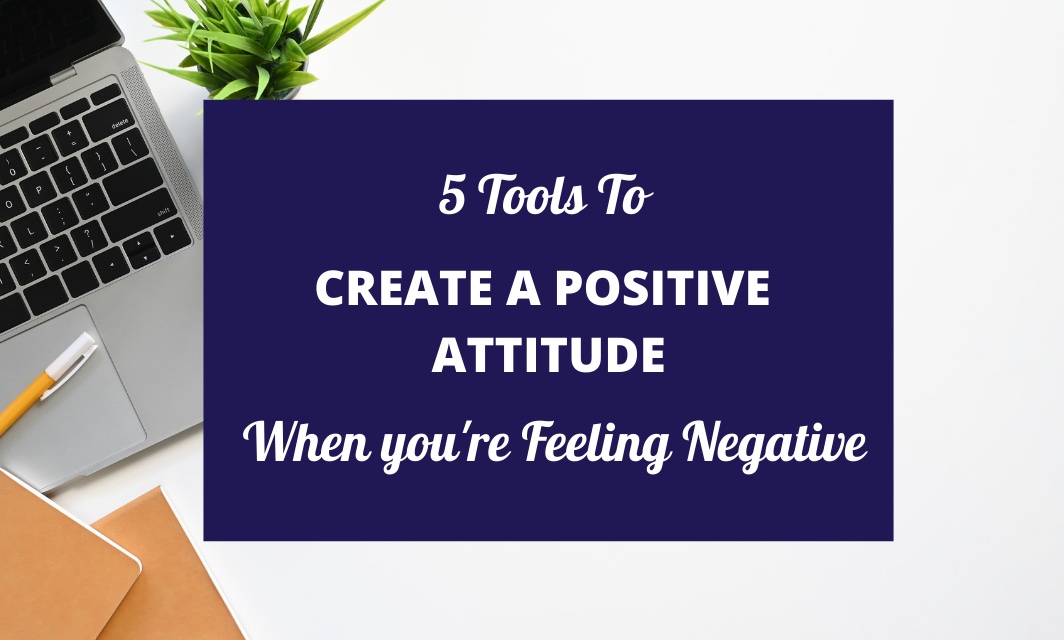So you’ve heard it’s important to maintain a positive attitude if you want to improve your results in life, but why is it important and how do you actually do it?
In this post, I’ll be sharing what attitude actually is, why it’s so important to maintain a positive attitude, my 5 tools to help you do this and what you can expect when you implement these ideas in your own life.
I’ve learnt to take serious, effective action as soon as an idea comes into my head and now have the ability to use those most important higher mental faculties of imagination and will, to implement like a boss!
And not only to start the task – but to work on it until it’s complete. Something I struggled with previously for decades.
What Is The Meaning Of Attitude?

Attitude is one of the most frequently used words in the English language and yet relatively few people actually understand what it means.
Parents tell children if they change their attitude, they’ll all get along better.
Teachers tell students if they change their attitude, their grades will improve.
Sales managers tell team members their sales will improve if they will only change their attitude.
When Doctors have done all they can, they tell their patients “Now it’s up to you; it’s all in your attitude.”
And yet, if you walked down the street asking people what attitude means, you would likely get a slew of different answers.
You would think something of this importance, something so powerful, should be explained to us (not simply expected of us) from a very early age and that we’d be actively taught and encouraged to use it effectively.
However, many people go through life without this knowledge, riding a roller coaster of emotions and living at the mercy of whatever gets ‘thrown their way’ on a day to day basis.
The unfortunate fact is that the vast majority of people are allowing their attitude to be controlled by outside forces – by the media, by other people, by external conditions and circumstances in their life.
When you have a deep, clear understanding of what attitude is and how attitudes are formed, it will quickly become apparent that only a tiny proportion of the world’s population are actually in control of their attitude.
Attitude is the composite of your thoughts, your feelings and your actions. You might also hear it referred to as ‘mood’
Most people don’t realise that they have sole and total control over their attitude or mood. They believe it is ‘given’ to them or ‘inflicted’ upon them by the situation they find themselves in.
But this is not so. Your attitude, or mood, can only come from inside you.
The thoughts you generate in your mind control your feelings, your feelings dictate the actions you take (including the things you say) and your actions dictate your results in life.
Why Is A Positive Attitude Important?

In his brilliant book, Lead The Field, Earl Nightingale says:
“It is our actions, feelings or moods that determine the action, feelings or moods of others. Our attitude tells the world what we expect in return. If it’s a cheerful, expectant attitude, it says to everyone with whom we come in contact that we expect the best in our dealings with the world.
You see, we tend to live up to our expectations. And others give to us, as far as their attitudes are concerned, what we expect. Our attitude is something we can control. We can establish our attitude each morning when we start our day – in fact, we do just that, whether or not we realise it.
And the people in our family – all the people in our world – will reflect back to us the attitude we present to them.
It is, then, our attitude toward life that determines life’s attitude toward us.”
This is the law of cause and effect in action.
We are producing causes all day long, every day that we live, and our environment can only return to us a corresponding effect.
In other words, we get back what we put out.
Each of us shapes our own life and, to a large degree, the quality of our life is determined by our habitual attitude. Learning a new habit of creating a positive attitude every morning on waking, and carrying it through the entirety of each day will change your world.
Most people never think about their attitude at all. They, sort of, wake up in ‘neutral’.
Their attitudes are neither positive nor negative, they’re simply waiting to see ‘what the day brings’, ready to react to whatever they encounter.
If what they encounter happens to be good, they will reflect it; if it’s bad they will reflect that.
They go through their day being influenced, and to a large extent controlled by, the actions of others and the conditions of their environment.
Their actions, and therefore their results, are a direct consequence of their reaction to what’s going on around them.
This is why it’s so important for us take control of ourselves and to make sure we have a positive attitude as often as possible.
How Can I Stay Positive When My Results Are Not What I Want?

For most of us, learning this new habit takes time and it’s developed the same way we develop any other ability; through practice!
We have a tendency to become consumed by our current results: the things that are happening in our lives at this moment in time.
But if our current results are not what we want, thinking about them over and over produces negative emotions, those emotions dictate the actions we take (or don’t take) and we find ourselves getting the same results.
The following 5 tools help my clients build the habit of maintaining a positive attitude throughout the day, even when things aren’t going quite to plan:
Positive Attitude Tool #1 - Gratitude

I (and my clients) begin each day with a Gratitude journal. As soon as you wake each morning, write out 10 things you are truly grateful for.
Give it some thought and only write down things you feel genuine gratitude for.
Maybe you’re grateful for your mental and physical well-being; for your happy, healthy children; for the opportunities that lay before you; for your morning coffee; for the roof over your head or the money to pay the bills this month…
It doesn’t matter how big or small they are or if they are the same things every day but try to come up with items that you are really thankful for.
It is this emotion, that raises your energetic level of vibration, makes you ‘feel’ good and sets you up with a positive attitude for the day ahead.
Tool #2 - Reminders

Sometimes simply reminding yourself to stay on task can be all you need to create a real difference.
Write out small signs (e.g. Post-It Notes or stickers) printed with the word ‘Attitude!” (or a drawing/symbol that reminds you of this word if you don’t want to make this exercise public knowledge!)
It’s a good idea to stick them on your car dashboard, the bathroom mirror, your computer screen, next to the kettle…
We need to smile more, speak to people, reach out to people, care about people.
We need to stop reacting to negative situations as if they are a personal attack (like being cut-up in your car or seeing a social media post you don’t like) and start responding instead.
Count to 10 before you say or do anything. Really think about what actions you are about to take: what ‘cause’ you will produce, and what effect that is likely to return to you.
Everything in the world we want to be, do or have must come with the assistance, in one form or another, of other people.
If you’ll begin to develop an attitude that says ‘yes’ to life and the world around you, the changes you see will be phenomenal.
Positive Attitude Tool # 3 – Expectation

Expect the best.
I teach my clients to expect to reach the goals they establish for themselves, to expect to get the results they want in all areas of their life.
Having a big goal to work towards is absolutely crucial for anyone wishing to advance in this life (and we should want to advance: the purpose of all life is fuller expansion and greater expression).
Focusing on those goals with the expectation that you will achieve them, is another tool to lift your vibration and create a positive attitude.
(You can read more about goal setting in my blog post https://www.emmahague.com/life-goal)
Successful people take the attitude that they can accomplish whatever they set out to accomplish. They hold the belief that there’s no good reason on earth why they can’t create the results they want in life.
They simply commit to working out what they need to do to achieve those things and doing them.
Practice the habit of believing there are more reasons why you can do something than there are reasons you can’t.
Even when things appear to be going badly, understand that, when you are focused on your goal, these hiccups are steps you must conquer to get to your final destination – they are merely lessons from which we must learn.
Use your higher mental faculty of Perception to look at any negative situations that crop up from a different angle and ask yourself “How can I make this work?” and then expect that you will.
Pretend if you have to at first! Pretend that you’re expecting to win at absolutely everything you put your hand to and see how quickly it becomes a habit-knit part of your attitude.
Tool #4 – The Impression Of Increase

In his book “The Science Of Getting Rich”, Wallace D Wattles talks about ‘The Impression Of Increase’.
He says “ The desire for increase in inherent in all nature; it is the fundamental impulse of the universe. All human activities are based on the desire for increase; people are seeking more food, more clothes, better shelter, more luxury, more beauty, more knowledge, more pleasure – increase in something, more life.
Every living thing is under this necessity for continuous advancement; where increase of life ceases, dissolution and death set in at once.”
It is because this is the deepest instinct of our nature that all men and women are attracted to those who can give them more in life, or can help them get it.
Treat every person you come into contact with as though he or she were the most important person on earth; in both your personal life and your professional life.
What can you say or do to help that person feel good?
Did the shop assistant serve you with an enthusiastic smile? Did the waiter go above and beyond his paid job for you? Has your daughter completed a task well that she didn’t want to do? Has your partner spent time making you a delicious dinner?
Tell them. This is not about false praise for praise’s sake, it’s about letting people know you appreciate them and have noticed the efforts they are making.
Make a commitment to practice this for the next 30 days with every single human being you come into contact with. How can you make them feel appreciated?
Remember, we get back what we put out.
Leaving everyone feeling better off for having interacted with you will make you feel good, raise your vibration and will ensure you receive good in return in the future.
Tool #5 – ‘Serenity’ Chapter

Of course there are all times when, try as we might, we really struggle to stick with these tools and find ourselves slipping into a poor attitude; getting annoyed at others and being frustrated with ourselves.
Relaxation plays a big part in what I teach as being able to stay calm in any situation is the key to controlling your thoughts and staying positive.
The more ways you can build relaxation methods into your daily routine, the more you will find you’re able to respond to situations calmly and without letting your emotions take over.
One of the tools I give my students is the last chapter (entitled ‘Serenity’) from William James’ little book ‘As A Man Thinketh’.
If they find they need some help getting their emotions under control; maybe they are prone to road (or trolley!) rage; maybe they find themselves constantly becoming annoyed with their children or spouse over small things; perhaps they become anxious and frustrated when making sales calls…
I prescribe reading this chapter every morning for 30 days. I suggest you do the same.
What Can I Expect If I Make These Changes?

When your attitude shifts, everything in your world shifts too.
If it shifts in a negative direction, your entire life shifts in that direction.
When it shifts in a positive direction, life improves.
Allowing your thoughts and, therefore, your attitude (or mood) to be controlled by outside forces means you are allowing those outside forces to determine the direction of your life.
Taking control of, and responsibility for, the thoughts you are having and the resulting attitude you are living with means you determine the results you experience in all aspects of your life.
You will feel better about yourself, about your own potential and about the people around you.
You’ll experience less worry, less frustration and less anger towards others.
In short, you will attract the happiness and success you desire.
It all rests on your attitude toward life and toward others.












